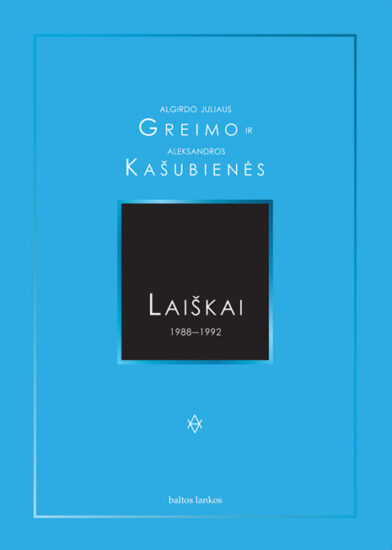Letters of Algirdas Julius Greimas and Aleksandra Kašubienė 1988-1992

HISTORY AND BIOGRAPHY
Letters of Algirdas Julius Greimas and Aleksandra Kašubienė 1988-1992 (Algirdo Juliaus Greimo ir Aleksandros Kašubienės laiškai 1988-1992), edited by Aleksandra Kašubienė, Vilnius: Baltos lankos, 2008, 240 pp.
The most distinguished Lithuanian semiotician and the founder of the Paris School of Semiotics Algirdas Julius Greimas (1917–1992) and the sculptor and architect Aleksandra Kašubienė-Kašuba (1923–2019), who attained fame in the US, befriended one another in Šiauliai during the Second World War while Aleksandra was still a pupil and Greimas, a mere five years older, was a teacher of French and Lithuanian. Their friendship, which began in 1941, was interrupted by war which drove Greimas to France for the rest of his life and Aleksandra, with her husband sculptor Vytautas Kašuba, to the States.
In 1988, when Aleksandra mustered the courage to send one of her manuscripts to Greimas, their friendship was revived in the form of letters – “as if we were continuing the interrupted conversation from where we had left off,” says Kašubienė. Their conversation lasted for several years until Greimas’s death on February 27, 1992 (the last letter which appears in the book was written in English by Aleksandra on March 16, already after Greimas’s death, and was addressed to his widow Teresa). Having begun in the summer of 1988 with polite, as if exploratory, exchanges, the correspondence between Kašubienė and Greimas soon gained momentum, spanning the inexhaustible themes of the epistolary genre: memories of their youth spent in Lithuania, witty outlines of mutual fondness (“You know, Algirdas, the two of us are capable of committing ‘promiscuity’ together with mere words”), the tangentially passing details of both of their everyday lives and affairs, Lithuania’s current affairs and brooding thoughts (Lithuania was breaking free from the Soviet occupation during the period of their correspondence), which are here and there overshadowed by seemingly endless speeches, delivered in writing, about philosophy and questions of meaning and signification. The correspondents constantly ask each other questions (Greimas a little more frequently) and deliberate over the nature of things such as life, death, beauty, lightness, balance, or fullness. Studying their correspondence, the curious reader observes how, little by little, Greimas discloses the areas of his scholarly undertakings and introduces Kašubienė to his works, never bragging about his knowledge or achievements, though both correspondents had plenty to brag about. In a letter dated March 28, 1990, Aleksandra writes, “Blessed be the ignorance that enabled me to communicate with you, for your contribution is frighteningly impressive.” In the same letter, Kašubienė states that, despite Greimas’s modest appraisal of the casual nature of the thoughts presented in the letters, they are all philosophy because they belong to a coherent system – the Greimas system. This system also unfolds in unexpected directions and in a non-scientific discourse, in these letters written in the Lithuanian language in all its richness – one that both Greimas and Kašubienė had preserved and cultivated throughout their life in emigration. Kašubienė concludes the last letter addressed to Greimas on January 25, 1992, with the words, “thank you for being who you are”. A reader of these letters of these two great 20th century Lithuanians could utter the same words: “thank you both, Greimas and Kašubienė, for being who you were. Great individuals. Of sharp mind, creative drive, and insightful thought.”
Aleksandra Fledžinskaitė-Kašubienė (Kašuba) – a Lithuanian-American environmental artist, a visionary of experimental tensile fabric structures. In 1942–43, she studied ceramics and sculpture at the Kaunas Institute of Applied Arts, and sculpture at the Vilnius Academy of Arts in 1943. In 1944, she fled to Germany. From 1947, she lived in New York, before moving to New Mexico in 2001. As an artist, she explored various means of expression including figurative ceramics and mosaics; from brick, marble, and granite, she created abstract wall reliefs for public spaces in US cities. Perhaps the most famous example of these reliefs is the wall decoration of the World Trade Center in New York, installed in 1986 and destroyed in 2001 together with the building itself during the 9/11 terrorist attacks. Before her death, Kašubienė donated 150 of her works created in 1953–2018 to Lithuania. The first retrospective of her work, ‘Shaping the Future: Environments by Aleksandra Kašuba’, will be presented at the National Gallery of Art in Vilnius from from the end of 2020 until early 2021.
Algirdas Julius Greimas was a distinguished semiotician, mythologist, linguist, cultural and social critic, and essay writer. A world-renowned scholar and the founder of the Paris School of Semiotics, he repeatedly noted that “to be a semiotician is to raise the question of meaning.”
Greimas graduated from Marijampolė Rygiškės Jonas Gymnasium, and studied law at Vytautas Magnus University (1934-1935) and linguistics at the University of Grenoble (1936–1939). In 1944, Greimas returned to France. In 1948, he defended his doctoral thesis ‘Fashion in the 1830s’ (published in 2000) at the University of Sorbonne. He taught at the universities of Alexandria, Ankara, Istanbul, and Poitiers. From 1965 onwards, he led a semiolinguistic research seminar in Paris, on the basis of which the Paris School of Semiotics was later founded. Most of his linguistic and semiotic works were written in French, while his studies of mythology and essays were all in Lithuanian. In his works, Greimas purposefully sought to present a scientific project of meaning, and he succeeded in doing so; most of his works, especially Structural Semantics (1966), show Greimas’s having developed semiotics – the general theory of meaning. Having established multiple centres for the study of semiotics, Greimas’s followers continue to develop and teach this humanities discipline at universities on at least three continents.